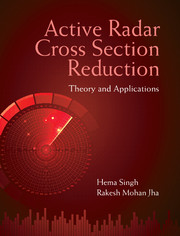Book contents
- Frontmatter
- Dedication
- Contents
- List of Tables
- List of Figures
- List of Abbreviations
- Preface
- Acknowledgements
- 1 Introduction to Radar Cross Section Reduction
- 2 RAM Analysis for Low-Observable Platforms
- 3 Radar Cross Section of Phased Antenna Arrays
- 4 Active RCS Reduction in Phased Arrays
- 5 Mutual Coupling Effects in Phased Arrays
- 6 RCS of Dipole Array Including Mutual Coupling Effects
- 7 Performance of Sidelobe Cancellers in Active RCSR
- 8 Emerging RCSR Techniques
- Epilogue
- Appendices
- List of Symbols
- Suggestions for Further Reading
- Author Index
- Subject Index
8 - Emerging RCSR Techniques
Published online by Cambridge University Press: 05 April 2015
- Frontmatter
- Dedication
- Contents
- List of Tables
- List of Figures
- List of Abbreviations
- Preface
- Acknowledgements
- 1 Introduction to Radar Cross Section Reduction
- 2 RAM Analysis for Low-Observable Platforms
- 3 Radar Cross Section of Phased Antenna Arrays
- 4 Active RCS Reduction in Phased Arrays
- 5 Mutual Coupling Effects in Phased Arrays
- 6 RCS of Dipole Array Including Mutual Coupling Effects
- 7 Performance of Sidelobe Cancellers in Active RCSR
- 8 Emerging RCSR Techniques
- Epilogue
- Appendices
- List of Symbols
- Suggestions for Further Reading
- Author Index
- Subject Index
Summary
Introduction
The active radar cross section reduction (RCSR) and the algorithms discussed in this book relate to the real-time RCSR and control of aerospace structures. The antenna array mounted over a platform actively adapts the pattern in coherence with the overall structural radar cross section (RCS) of the platform. The pattern adaptation depends on parameters such as the number of radar sources, their frequencies, the angle of arrival, the power levels, and the bandwidth. The RCS of aerospace platform with phased array mounted over it is reduced towards each of the hostile probing sources while simultaneously maintaining communication links with friendly radars.
Apart from the concept of active RCSR, several other techniques and ideas have been proposed towards achieving low observability through passive means. These include the usage of engineered materials, i.e. frequency selective surfaces (FSS), artificial magnetic conductor (AMC), metamaterials, conformal load-bearing antennas, etc. The research is emphasised towards the miniaturisation, bandwidth enhancement and conformality of the structures. This is especially true for the antennas mounted over the surface of aerospace structures. Typically, RCS of a non-stealthy aircraft may vary from 10 dBsm to 30 dBsm, whereas missiles have relatively lower RCS (–20 dBsm to 10 dBsm) (Doan et al. 1995) (Paterson 1999). Moreover, various sensors and antennas are mounted over these platforms owing to applications such as surveillance, tracking and reconnaissance and, hence, contribute to the overall RCS of the platform. Extensive studies have, therefore, been done to reduce the antenna RCS (Volakis et al. 1992), (Zhang et al. 2012). The solutions proposed include the shaping of the surface, application of radar absorbing material (RAM) (Pozar 1992), (Wang et al. 2011), using tapered resistive sheets in antenna (Gustafsson 2006), and (Genovesi et al. 2012) in radome, passive RCSR (Knott et al. 2004) and active RCSR. Scattering at the edges can be suppressed effectively by using tapered loading.
- Type
- Chapter
- Information
- Active Radar Cross Section ReductionTheory and Applications, pp. 268 - 282Publisher: Cambridge University PressPrint publication year: 2015



